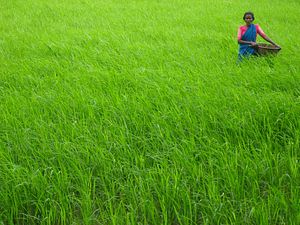According to the United Nations Millennium Development Goals (MDG) report for 2014, which was released on July 7, 2014, India has the largest number of poor individuals out of any country in the world. The report defined extreme poverty as living on below $1.25 a day. The world has 1.2 billion people who fit this definition, of which one-third (400 million) live in India. South Asia as a whole has done poorly in accomplishing its 2015 MDG targets in reducing poverty, while East Asia and Southeast Asia have largely met their targets.
India’s failure at tackling poverty is not just limited to the average income of its population but includes numerous failures in tackling basic public health issues such as infant mortality and maternal health. Over a quarter of the world’s maternal deaths occur in India, for example. While this is shocking, it is not surprising for India watchers and experts. As one of them, Nobel laureate Amartya Sen, warned in his book on development in India, India’s past governments have largely overlooked the necessity of basic human development.
Poorer countries such as Sri Lanka and Bangladesh have done much better than India on these counts because their development strategies have been much more focused on the basics. For example, Bangladesh has essentially stamped out the practice of open defecation while India still has 600 million individuals who defecate in the open. India’s situation can be attributed to the government’s hands-off, indifferent approach. As I noted in previous articles, this approach is due to the government and elite’s tendency to focus on pursuing global or prestigious agendas while neglecting the stark reality of life throughout most of their own country. Problems of this scale and complexity can only be solved if the government gets involved and not by private initiative alone. Perhaps the government’s attitude will change now that the more-in-touch Bharatiya Janata Party (BJP) has come to power in India.
South Asia, including India, also has the greatest percentage of malnourished children out of any region in the world, including Sub-Saharan Africa. Among children under the age of five in South Asia, over 30 percent are underweight. Food security is a major problem in all of South Asia, including India, and is caused more by flawed policies than by a lack of food itself. India’s food consumption patterns are incredibly diverse, with people consuming either more wheat or rice in different states and in rural and urban areas, making it difficult to create a centralized strategy for combating hunger.
Perhaps one trend, though, will alleviate hunger and provide more calories for the average Indian. This trend is the rising meat consumption of the average Indian, which makes use of an additional, plentiful food resource that exists all over India. Contrary to popular belief, India has always been a meat-eating country, with 60 percent of the population eating meat. Vegetarianism has traditionally been limited to only certain castes and religious groups, and even this is changing. Today, India is home to the world’s fourth fastest growing market for chicken, and the seventh fastest growing market for fish. Chicken and fish are the two most popularly consumed meats in India, since there are no religious taboos associated with them, unlike beef and pork. Despite these changes, India still needs a comprehensive policy for increasing caloric intake so as to improve both public health and the food security of its entire population.
India’s government has acknowledged these problems and has admitted that the country has a long way to go. Minority Affairs Minister Najma Heptullah said that there was much work to be done but that the new government is committed to improving India’s record on basic developmental issues. Heptullah promised that “when the fifteen-year review of the millennium development goals is undertaken in 2030, India will present a very different and upbeat picture.” Prime Minister Modi is committed to poverty reduction, having coined the development mantra “सबका साथ, सबका विकास” (sabka saath, sabka vikaas) – “with all, development for all.”
Policies aimed at improving agricultural techniques and expanding industrial output would create the economic conditions necessary for uplifting the average Indian. India’s previously narrow focus on services, while contributing to economic growth, could not create the type of holistic growth that would benefit the entire population. Yet, while India has a long way to go, there is some positive news in the report: India has achieved almost universal school enrollment.

































